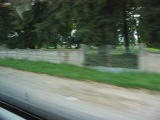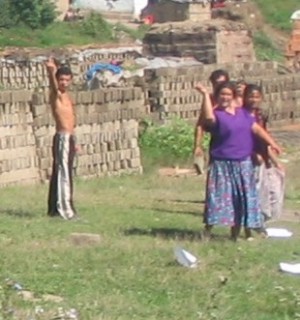YES: Tundeka is wearing a BSO Seiji Ozawa t-shirt!
YES: Tundeka is wearing a BSO Seiji Ozawa t-shirt! |
| Driving in Romania is a special skill. It often
involves getting very close and waiting for just the right moment to pass.
In this case, we are in the second van, while the lead van attempts to go
around a combine in the center of a town along Route 1. The pass is delayed - as often it is - by an oncoming cart. The mix of vehicles is truly amazing. Later in the trip I noticed a horse-drawn cart on a major highway -- carrying a small car! We often found ourselves inhaling sharply as we passed oh-so-close to the slower vehicles. I tried to capture the sensation on the video clip below. 
Click to animate |

| Paloma and Samantha found a great place ot pose
in the gardens of Gyulafehervar (Alba Julia). Contrasts in the landscape of Gyulafehervar are demonstrated in the garden photographs below, both of which were taken from the front of the yellow church building shown just below them.) The large apartment blocks have helped to transform this into an urban center, even though agricultural land is surprisingly close by. The stark lines of the buildings stand in sharp contrast to the ornate wood carvings and flowers of the church garden. Barely visible in the middle distance is another very ornate church building, which we did not have an opportunity to visit. The picteresque line of site between the two churches is not enhanced by the incongruous architecture of Ceaucescu. |
| As we drove west toward Torocko, we passed through
Kokoz and the beautiful Valley of Stone. A brief stop along the road was
a good opportunity to explore an alpine stream and meadow, while a castle
and a campground loomed above us. The entire area is very popular with tourists
from all over Europe, particularly from Hungary. |

|
Torocko is a lovely village whose Unitarian church is partnered with the Unitarian congregation of Wellesley Hills, Massachusetts. The church maintains a guest house in the center of the village that was a lovely place for our group to stay. The communal porch was great for reading, writing, and conversation. The large bunk rooms reminded many of us of the church camps of our younger days. |
| Samantha and Paloma loved it when the goats came
to the village center for water. We were all fascinated when the cows came
home. Click the image below for a brief video of the event. |